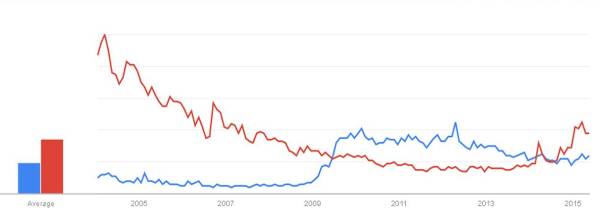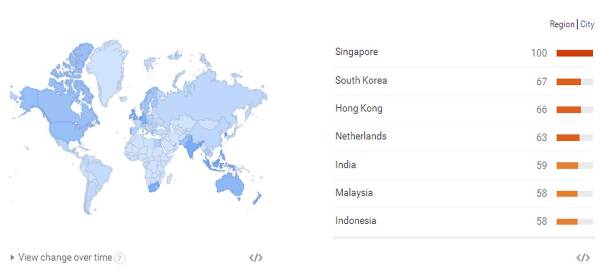In my Display Daily articles, mobile devices are a common topic and among those, augmented or virtual reality glasses are very dear to my heart.

Many years ago I argued with a colleague that I would wear a comfortable headset that provides me with the same experience as a good sized/quality monitor on my desk. He argued that this will never happen and so far he is right. I still hope though that one will come out with a headset that fulfills my demands of comfort, display size and quality.
I have tried on many headsets and while I have found devices that deliver one of my expectations, none has delivered all of them in the same device. It seems we are just not ready yet.
On the other hand there is no tech blog that does not report on the newest and latest smartglass device. Meanwhile, other analysts point their fingers at Hollywood as it seems that no successful movie can be without eyewear. Whatever the reason, I checked on Google how the worldwide interest based on the search terms “augmented reality” and “virtual reality” is and has developed over time. Google allows such searches via Google trends, a very nifty little tool.
Let us first take a look at the historical development of searches for these terms as shown in the following graph.
 Google Trends: Searches for Augmented Reality (blue) and Virtual Reality (red)The results are not exactly what I envisioned at all. While virtual reality was a popular search term 10 years ago, it only recently started rising again mainly driven by virtual hardware like the Oculus Rift and the acquisition of the company by Facebook. Augmented reality on the other hand shows a growing interest measured by the number of Google searches starting in 2009, way before the event of Google Glass announcements.
Google Trends: Searches for Augmented Reality (blue) and Virtual Reality (red)The results are not exactly what I envisioned at all. While virtual reality was a popular search term 10 years ago, it only recently started rising again mainly driven by virtual hardware like the Oculus Rift and the acquisition of the company by Facebook. Augmented reality on the other hand shows a growing interest measured by the number of Google searches starting in 2009, way before the event of Google Glass announcements.
Another way to look at it is the global distribution of web searches. The following two images show the distribution by countries.
 Google Trends: Distribution of Searches for Augmented Reality
Google Trends: Distribution of Searches for Augmented Reality
 Google Trends: Distribution of Searches for Virtual Reality
Google Trends: Distribution of Searches for Virtual Reality
This is quite a surprising result. There is a distinct difference in the regional distribution of these two search terms. While the general distribution seems to be similar as seen by the darker shades of blue, the top seven countries for each term are different. The only two countries that are on both top seven lists are India and Malaysia.
There is no real easy explanation for this, however there is always the possibility that these two terms are used somewhat interchangeably depending on the cultural background. The accurate use of a technical term is not easy to come by, even for technology insiders. Why are so many still referring to a 4k TV, when the real term would be UHD TV?
In recent months, we have reported on several uses of augmented and virtual reality in the vertical industrial market as well as in education and medical research. While this kind of application may benefit from the augmented or virtual reality technology in quantifiable measures, the real goal for CE companies is the use by the average consumer. This is a goal that so far has evaded all the companies involved.
Nevertheless, we are inspired by these science fiction like devices that put us on the same level as Iron Man and the like – having information at hand when we need it and performing functions that are far outside our normal reach. We should keep in mind that even Iron man does not show up with an augmented reality system for dinner, work or other everyday task.
And this may be the issue here. We all may have different expectations of what an augmented reality system can do for us, but acceptance in society for wearing such gear is very low so far. If this is really the main barrier to entry then it will take a major change in the public perception of the technology before we can see widespread adoption. Such a change takes years or even decades based on historic data.
Adoption will have to come in very defined markets, where the advantages of the technology overcome the social pressures. This is exactly what we are seeing in the market today. Augmented and virtual reality applications focus on functions that make sense from a business, performance or otherwise measurable perspective. We may get used to wearing these headsets at work and sometime in the future we may not take them off when we leave.
Now, if they would finally make a headset that is comfortable and provides great visual performance, I am in, for work at least. – Norbert Hildebrand

